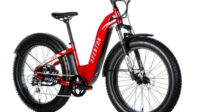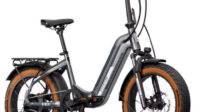
Electric bikes and mopeds offer two distinct options for personal transportation, each with its set of advantages and disadvantages.
In this article, we’ll provide an objective comparison of these two forms of transportation, exploring the pros and cons of electric bikes and mopeds to help you make an informed decision about which one is best for your needs.
1. Cost Considerations
Mopeds: Mopeds are known for their affordability, making them a cost-effective mode of transportation for many. However, it’s essential to consider potential maintenance costs due to their gas-powered engines. Gas-powered vehicles tend to have more moving parts, which can lead to higher maintenance expenses over time.
Electric Bikes: While the upfront cost of electric bikes may be higher, the long-term maintenance costs are generally lower. Electric bikes have fewer moving parts, and the maintenance primarily involves standard bicycle upkeep, such as tire changes and brake adjustments. This results in potential long-term savings on maintenance.
2. Rideability
Mopeds: Mopeds offer the advantage of longer travel distances, thanks to their gas-powered engines. They can be quickly refueled at gas stations, extending their range significantly. Mopeds are ideal for those who require extended daily commutes.
Electric Bikes: Electric bikes provide the convenience of charging at home using a standard 110-volt outlet. However, their range may be more limited, especially if you don’t carry spare batteries. For those with shorter commutes or the ability to recharge at their destination, electric bikes are a suitable option.
3. Speed and Torque
Mopeds: Mopeds typically reach top speeds of around 30 miles per hour, making them well-suited for urban commuting and keeping up with traffic. Some riders may choose to modify their mopeds to achieve higher speeds.
Electric Bikes: Electric bikes generally have an average speed ranging from 20 to 28 miles per hour. Some models can reach higher speeds, offering a sense of swiftness and efficiency. Electric bikes are lightweight, making them ideal for urban travel.
Also read about Electric Bikes vs Regular Bikes.
4. Power and Climbing Ability
Mopeds: Mopeds provide a stable and powerful ride, making them suitable for various terrains. However, they may not be as efficient at climbing steep hills compared to electric bikes with mid-drive systems.
Electric Bikes: Electric bikes, especially those equipped with mid-drive systems, excel at climbing steep hills. They leverage all available gears and can efficiently navigate challenging inclines. The flexibility of electric bikes allows riders to choose the level of assistance they desire, from a full workout to a more relaxed ride.
5. Weight and Portability
Mopeds: Mopeds are considerably heavier, often weighing several hundred pounds. Their weight can pose challenges in terms of transportation, particularly if they break down or require maintenance. They usually necessitate a truck or additional assistance for transport.
Electric Bikes: Electric bikes are notably lighter, typically weighing between 40 to 50 pounds. Their lightweight nature makes them easy to lift and transport, even for individuals without significant physical strength.
Also read about e-bike for seniors.
6. Licensing and Registration
Mopeds: Operating a moped usually requires annual registration, safety checks, and a valid driver’s license. These additional requirements can be a drawback for some riders.
Electric Bikes: In many states, electric bikes are considered similar to regular bicycles. They require a one-time registration fee that is often significantly lower than moped registration fees. You do not need a driver’s license to operate an electric bike, making them more accessible to a broader range of riders.
7. Environmental Impact
Mopeds: Mopeds are gas-powered vehicles, producing emissions, noise, and pollution. While they are more fuel-efficient than cars, they still contribute to environmental degradation.
Electric Bikes: Electric bikes offer a more eco-friendly alternative. They produce zero emissions, generate minimal noise, and operate silently. Riding an electric bike is an environmentally responsible choice.
Conclusion
In the comparison between electric bikes and mopeds, the choice ultimately depends on your specific needs and preferences. While mopeds offer extended range and stability, electric bikes are lightweight, cost-effective in the long run, and environmentally friendly. Consider your daily commute, terrain, budget, and environmental concerns when making your decision.
Electric bikes have gained popularity for their versatility and eco-friendliness, making them a compelling option for many urban and suburban riders. It’s essential to weigh the pros and cons carefully to determine which mode of transportation aligns best with your lifestyle and priorities.
- 12 Kata-Kata Bijak Pentingnya Komunikasi yang Baik, Tiket Menuju Sukses – November 15, 2023
- 35 Quotes tentang Public Speaking yang Menginspirasi – November 15, 2023
- Review Sepeda Listrik Uwinfly Dragonfly 7 (DF7) – November 14, 2023






